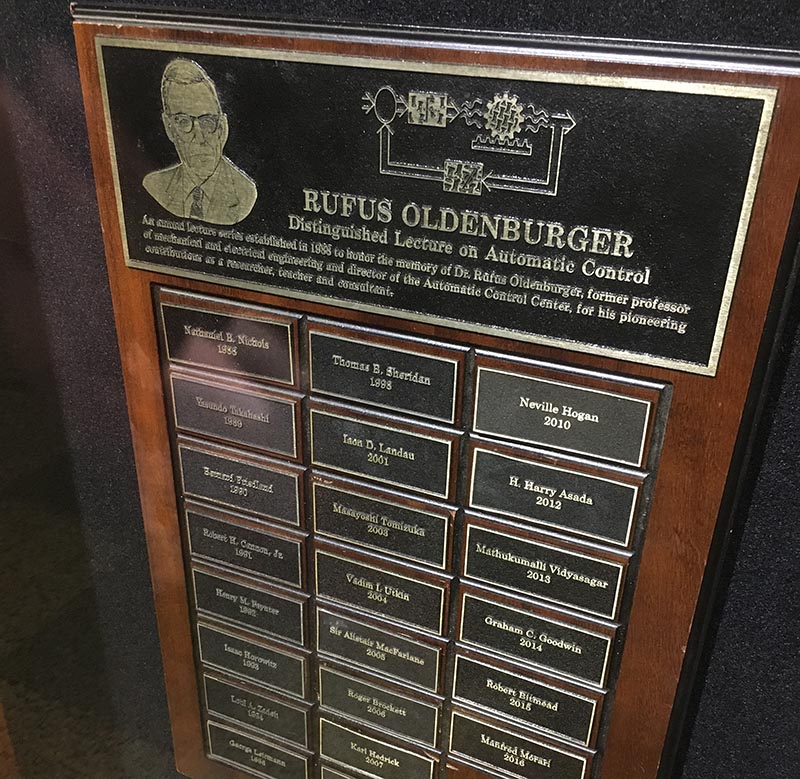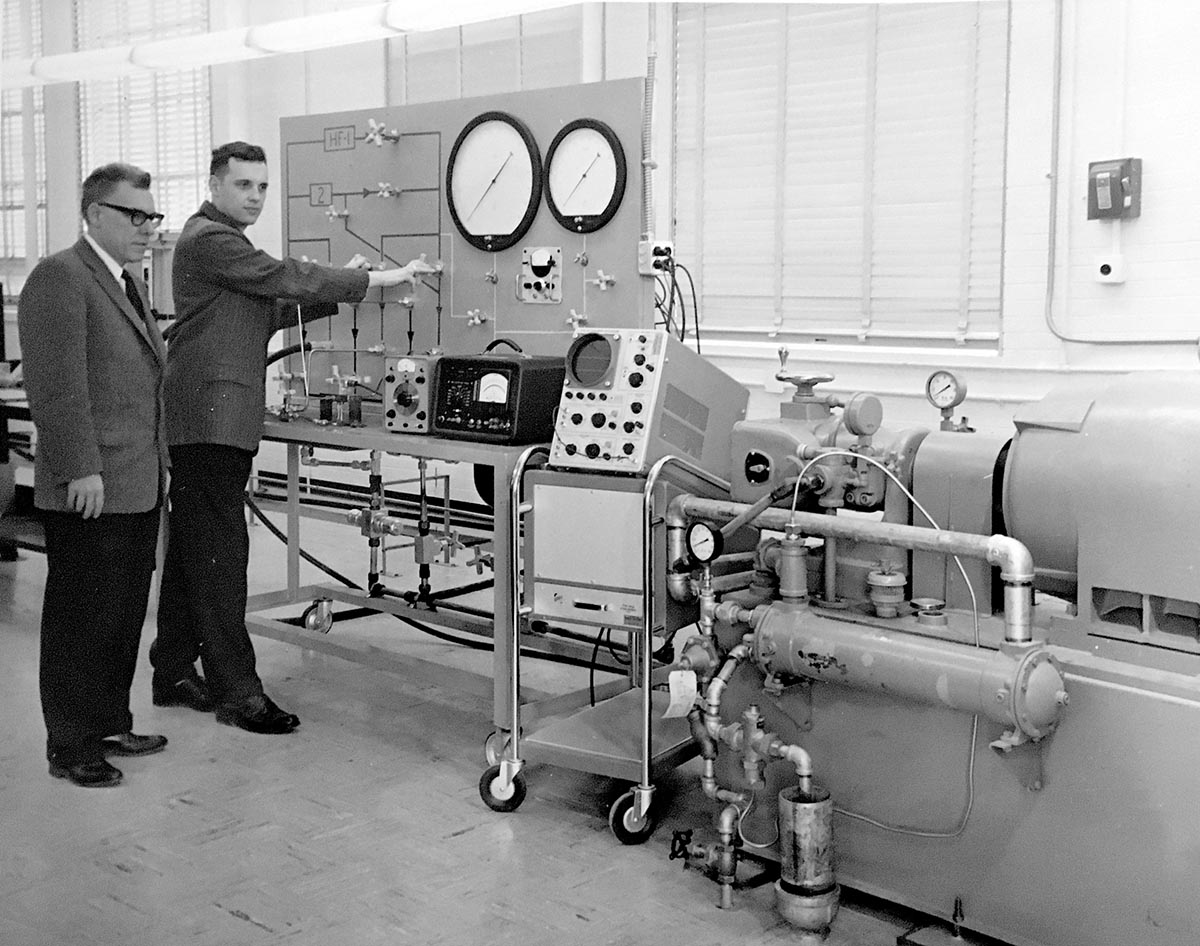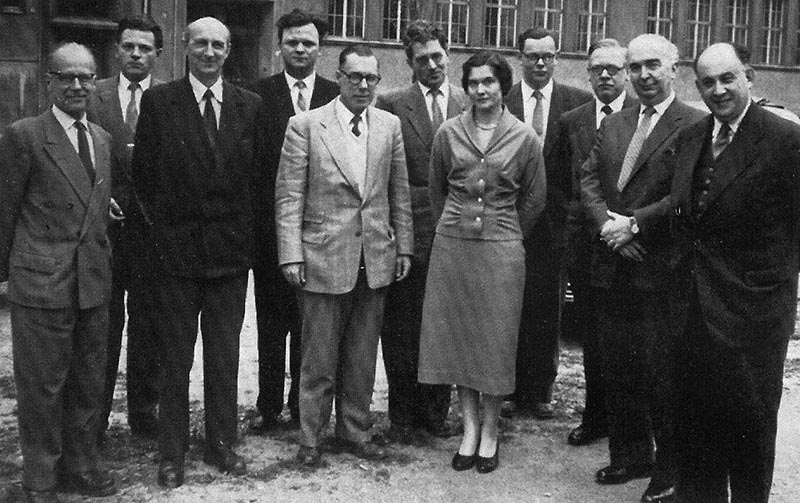Rufus Oldenburger: Pioneer of Automatic Control
 The plaque on the wall says, "Rufus Oldenburger Distinguished Lecture on Automatic Control." Students pass by it every day, in the hallway of the Mechanical Engineering building at Purdue University. It lists a who's who of distinguished faculty, academic researchers, and industry practitioners -- all of whom have personally visited Purdue to lecture in the field of automatic control. While students may be curious about the names, it's the one at the top that is most notable: Oldenburger.
The plaque on the wall says, "Rufus Oldenburger Distinguished Lecture on Automatic Control." Students pass by it every day, in the hallway of the Mechanical Engineering building at Purdue University. It lists a who's who of distinguished faculty, academic researchers, and industry practitioners -- all of whom have personally visited Purdue to lecture in the field of automatic control. While students may be curious about the names, it's the one at the top that is most notable: Oldenburger.
"He was really ahead of his time," said Peter Meckl, professor of mechanical engineering at Purdue, and also the chair of the Systems, Measurement, and Control area. "We are fortunate here at Purdue to share in that legacy."
To learn about that legacy -- which includes Albert Einstein, Ernest Hemingway, the King of Norway, the Saturn rocket, and a 1956 Ford Thunderbird -- we have to go back to the beginning.
Rufus Oldenburger was born in Grand Rapids, Michigan on July 6, 1908. He showed equal aptitude for humanities and sciences, getting a double major from the University of Chicago in Latin and Greek, as well as mathematics. After a masters and Ph.D., he seemed destined for the academic life. He taught mathematics at the University of Michigan, Case Institute of Technology (now Case Western Reserve University), Illinois Institute of Technology, DePaul University, and Princeton University, where he worked with Albert Einstein.
But then industry came calling. In 1942, he became director of research at Woodward Governor Company, whose main business at the time involved turbines for hydroelectric power plants. "Oldenburger was a mathematician, not an engineer," said Meckl. "But here was this company dealing with practical issues with real systems on real machines. They needed a way of understanding these systems that only someone with a math background could appreciate." The exchange worked both ways: Oldenburger also came to appreciate that the pure math in his field could be applied to real-world physical systems.
The timing couldn't have been better. America was about to embark on a journey that required a great deal of high-level math, applied to complex systems. Having joined the faculty of Purdue University in 1956, Rufus Oldenburger was perfectly positioned to influence the space race. He founded the Automatic Control Center at Purdue, and utilized Purdue's facilities and prowess in engineering to conduct pioneering research. "My dad worked with NASA quite a bit," said Derek Oldenburger, Rufus Oldenburger's son. "On the Saturn rocket, they had a problem with vibration, and he solved that for them. He also worked on the guidance system for the Mariner spacecraft."
 "This was the age of Sputnik," said Gene Goodson, who in 1956 was an undergraduate engineering student. "The U.S. was responding to, 'We can't let the Russians beat us!' After all, they had a satellite, and we didn't have one. So the demand for controls really accelerated." Interested in the field, Goodson wasted no time in going straight to the source. "I called him up personally," said Goodson, "and said I'd like to come work for him at Purdue. He accepted me right over the phone!"
"This was the age of Sputnik," said Gene Goodson, who in 1956 was an undergraduate engineering student. "The U.S. was responding to, 'We can't let the Russians beat us!' After all, they had a satellite, and we didn't have one. So the demand for controls really accelerated." Interested in the field, Goodson wasted no time in going straight to the source. "I called him up personally," said Goodson, "and said I'd like to come work for him at Purdue. He accepted me right over the phone!"
The Automatic Control Center took up a large section of the ground floor in Purdue's Mechanical Engineering building. "We had a large hydraulic motor and high-pressure pumps," said Goodson, "and that fed into a panel with a frequency generator and an analog computer. It made quite a racket when it was all running."
"At that time, control systems were called servomechanisms," said John Nicklas, another student of Oldenburger's, who had come from Rocketdyne in California. "He was primarily a mathematician, so experimental work was relatively new to him. He had a way of manually factoring sixth or seventh order equations in a short period of time. This was something I'd never seen anyone else do."
Both Goodson and Nicklas published papers with Oldenburger. "We were a pretty dedicated group," said Goodson. "We worked long hours, and Oldenburger mentored us well. Being a mathematician, precision was extremely important to him. Our speech and grammar had to be spot on, and our equations had to be in the right place. It served us well, because most of us got great jobs after we left!" Indeed, Goodson himself eventually became a professor at Purdue, and took over the Automatic Control Center.
It wasn't all toil, however. "I remember him buying a 1956 Ford Thunderbird," said Goodson. "It was white, with a hard top, and the round side windows. He was very proud of that car!"
"That was a beautiful car," remembered his son Derek. "He had actually designed the speed control for that car!"
Rufus Oldenburger also entertained, along with his wife, Eleanor. "I remember going to the basement of their house, with a big bar," said Goodson. "He and his wife made an absolutely wonderful pair. She was an elegant, intelligent woman, and had spent a lot of time overseas."
"My mother spoke French," said Derek, "and had spent time in Paris, working at the Shakespeare and Company bookstore. Ernest Hemingway would visit, and my mother once got in trouble for presenting him with a bill for what he'd taken!"
Rufus Oldenburger was also well travelled, and spoke nearly a dozen languages. "I remember traveling to Japan, and being guests of the Japanese government," said Derek. "And we traveled to India, and were guests of the Indian government. In Oslo, Norway, he was a guest of the King."
One of Oldenburger's stops was the Soviet Union, home to many of the giants in the mathematics field. But at the height of the Cold War and the Space Race, these Eastern scientists remained hidden behind an Iron Curtain. Oldenburger wanted to change that.
 "He wanted to take the politics out of it and say, 'We are just interested in the science of automatic control,' " said Peter Meckl. "He began to conceptualize the idea of an International Federation of Automatic Control, where people from every country could get together and share ideas. It was an incredible opportunity to meet these Russian mathematicians face-to-face, rather than just reading about them. In fact, the first IFAC Congress in 1960 was actually held in Moscow."
"He wanted to take the politics out of it and say, 'We are just interested in the science of automatic control,' " said Peter Meckl. "He began to conceptualize the idea of an International Federation of Automatic Control, where people from every country could get together and share ideas. It was an incredible opportunity to meet these Russian mathematicians face-to-face, rather than just reading about them. In fact, the first IFAC Congress in 1960 was actually held in Moscow."
IFAC is now celebrating its 60th anniversary, boasting more than 2,000 members and 40+ conferences every year around the world. "The great part about IFAC is you get to meet people from every field," said Meckl. "There are people from chemical engineering, electrical engineering, mechanical engineering and more. We might not ever get the chance to interact otherwise, but we all work on automatic control."
Rufus Oldenburger died in 1969. His legacy lives on in several tangible ways, including the Rufus Oldenburger Medal -- awarded by the American Society of Mechanical Engineers for lifetime achievements in automatic control.
Purdue University claims a particular affinity for Oldenburger's legacy. "Because Oldenburger achieved so much here at Purdue," said Meckl, "we wanted the opportunity to showcase the best and brightest from his field to our students. In 1988, his wife Eleanor helped to establish the Rufus Oldenburger Lecture. Every year, the winners of the Rufus Oldenburger Medal come to campus to lecture and interact with our students."
And the field of controls itself is also alive and well with today's generation of engineering students. "We lay the foundations for controls early on," said Meckl. "Of course we now have software tools that can easily solve those functions, and new hardware like microcontrollers and sensors. The fundamental concepts haven't changed, but what has changed is the speed and ease of getting an answer, using those concepts. It enables students today to do things that were unimaginable in Oldenburger's day."
Rufus Oldenburger's legacy is far more than a plaque on a wall. It's in the spacecraft that landed men on the moon. It's in the handshakes between Eastern and Western scientists during the Cold War. And it's in the fundamental concepts that will enable today's Purdue University students to pioneer the next generation of amazing technology.
Read Rufus Oldenburger's documentation of the beginnings of IFAC.
